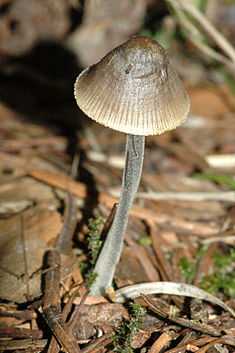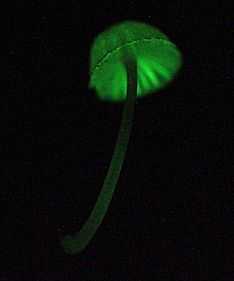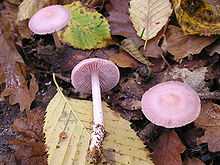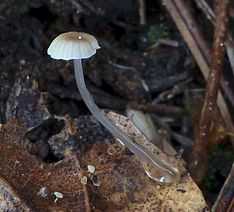List of bioluminescent fungi
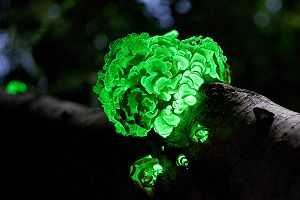
Found largely in temperate and tropical climates, there are more than 70 species of bioluminescent fungi, all of which are members of the order Agaricales. All known representatives are mushroom-forming, white-spored agarics that belong to four distinct evolutionary lineages. The Omphalotus lineage (comprising the genera Omphalotus and Neonothopanus) contains 12 species, the Armillaria lineage has 5 species, while the Mycenoid lineage (Mycena, Panellus, Prunulus, Roridomyces) has 47 species. The recently discovered Lucentipes lineage contains two species, Mycena lucentipes and Gerronema viridilucens, which belong to a family that has not yet been formally named.[1] Armillaria mellea is the most widely distributed of the luminescent fungi, found across Asia, Europe, North America, and South Africa.[2]
Bioluminescent fungi emit a greenish light at a wavelength of 520–530 nm. The light emission is continuous and occurs only in living cells.[3] No correlation of fungal bioluminescence with cell structure has been found. Bioluminescence may occur in both mycelia and fruit bodies, as in Panellus stipticus and Omphalotus olearius, or only in mycelia and young rhizomorphs, as in Armillaria mellea.[4] In Roridomyces roridus luminescence occurs only in the spores, while in Collybia tuberosa, it is only in the sclerotia.[5]
Although the biochemistry of fungal bioluminescence has not fully been characterized, the preparation of bioluminescent, cell-free extracts has allowed researchers to characterize the in vitro requirements of fungal bioluminescence. Experimental data suggest that a two-stage mechanism is required. In the first, a light-emitting substance (called "luciferin") is reduced by a soluble reductase enzyme at the expense of NAD(P)H. In the second stage, reduced luciferin is oxidized by an insoluble luciferase that releases the energy in the form of bluish-green light. Conditions that affect the growth of fungi, such as pH, light and temperature, have been found to influence bioluminescence, suggesting a link between metabolic activity and fungal bioluminescence.[5]
All bioluminescent fungi share the same enzymatic mechanism, suggesting that there is a bioluminescent pathway that arose early in the evolution of the mushroom-forming Agaricales.[1] All known luminescent species are white rot fungi capable of breaking down lignin, found in abundance in wood. Bioluminescence is an oxygen-dependent metabolic process because it provides antioxidant protection against the potentially damaging effects of reactive oxygen species produced during wood decay. The physiological and ecological function of fungal bioluminescence has not been established with certainty. It has been suggested that in the dark beneath closed tropical forest canopies, bioluminescent fruit bodies may be at an advantage by attracting grazing animals (including insects and other arthropods) that could help disperse their spores. Conversely, where mycelium (and vegetative structures like rhizomorphs and sclerotia) are the bioluminescent tissues, the argument has been made that light emission could deter grazing.[5]
The following list of bioluminescent mushrooms is based on a 2008 literature survey by Dennis Desjardin and colleagues,[6] in addition to accounts of several new species published since then.[7][8][9][10]
Key
| Name | The binomial name of the fungal species, including the author citation—the person who first described the species using an available scientific name, using standardized abbreviations. |
|---|---|
| Luminescence | Indicates which form of the fungus—mycelium or fruit body—produces luminescence. |
| Distribution | The geographical distribution of the species. AF=Africa; AS=Asia; AU=Australasia; CA=Central America and the Caribbean; EU=Europe; NA=North America; SA=South America |
| References | Literature sources where bioluminescence was reported. |
Species

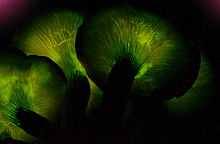
| Binomial | Luminescence | Distribution | References | |
|---|---|---|---|---|
| Mycelium | Fruit body | |||
| Armillaria fuscipes Petch |
yes | no | Malaysia | [4][11][12] |
| Armillaria gallica Marxm. & Romagn. |
yes | no | EU, NA | [13] |
| Armillaria mellea (Valh.) P.Kumm. |
yes | no | EU, NA | [13] |
| Armillaria ostoyae (Romagn.) Henrik |
yes | no | EU, NA | [14] |
| Armillaria tabescens (Scop.) Emel |
yes | no | EU, NA | [13] |
| Dictyopanus foliicolus Kobayasi |
yes | yes | Japan | [15][16] |
| Dictyopanus pusillus var. sublamellatus Corner |
? | yes | SA | [17] |
| Filoboletus pallescens (Boedijn) Maas Geest. |
? | yes | Malaysia | [18] |
| Filoboletus yunnanensis P.G.Liu |
? | yes | China | [18] |
| Gerronema viridilucens Desjardin, Capelari & Stevani |
yes | yes | SA | [19] |
| Lampteromyces luminescens M.Zang |
? | yes | China | [20] |
| Mycena asterina Desjardin, Capelari & Stevani |
yes | yes | SA | [21] |
| Mycena cahaya A.L.C.Chew & Desjardin |
yes | yes | Malaysia | [22] |
| Mycena citricolor (Berk. & M.A.Curtis) Sacc. |
yes | no | SA, CA | [12][23] |
| Mycena chlorophos (Berk. & M.A.Curtis) Sacc. |
yes | yes | Malaysia, Japan, Pacific Islands | [17] |
| Mycena daisyogunensis Kobayasi |
? | yes | Japan | [15] |
| Mycena deeptha Aravind. & Manim. |
yes | no | India | [9] |
| Mycena discobasis Metrod |
? | yes | SA, AF | [21] |
| Mycena epipterygia (Scop.: Fr.) S.F.Gray |
yes | no | EU, NA, Japan | [24] |
| Mycena fera Maas Geest. & de Meijer |
? | yes | SA | [21] |
| Mycena galopus (Pers.: Fr.) P.Kumm. |
yes | no | EU, NA, Japan | [12][24][25] |
| Mycena haematopus (Pers.: Fr.) P.Kumm. |
yes | yes | EU, NA, Japan | [25][26] |
| Mycena illuminans Henn. |
? | yes | Malaysia, Japan | [17][27][28] |
| Mycena inclinata (Fr.) Quél. |
yes | no | EU, NA, AF | [11] |
| Mycena kentingensis | yes | Taiwan | [10] | |
| Mycena lacrimans Singer |
? | yes | SA | [21] |
| Mycena lamprospora (Corner) E.Horak |
no | yes (spores) | Malaysia, AU | [28][29][30] |
| Mycena lucentipes Desjardin, Capelari & Stevani |
yes | yes | SA, CA | [21] |
| Mycena lux-coeli Corner |
? | yes | Japan | [17] |
| Mycena luxaeterna B.A.Perry & Desjardin |
yes | yes | SA | [7] |
| Mycena luxarboricola B.A.Perry & Desjardin |
no | yes | SA | [7] |
| Mycena luxperpetua B.A. Perry & Desjardin |
yes | yes | Puerto Rico | [7] |
| Mycena maculata P.Karst. |
yes | EU, NA, AF | [25] | |
| Mycena manipularis (Berk.) Métrod |
yes | yes | AU, Malaysia, Pacific islands | |
| Mycena manipularis var. microporus Kawam. ex Corner |
? | yes | Pacific islands | [17] |
| Mycena noctilucens Kawam. ex Corner |
? | yes | Malaysia, Pacific islands | [17][28] |
| Mycena noctilucens var. magnispora Corner |
? | yes | Pacific islands | [28] |
| Mycena olivaceomarginata (Massee apud Cooke) Massee |
yes | no | EU, NA | [11] |
| Mycena polygramma (Bull.: Fr.) S.F.Gray |
yes | no | AF, EU, NA, Japan | [12][24][25] |
| Mycena pruinoso-viscida Corner |
? | yes | Malaysia | [17][28] |
| Mycena pruinoso-viscida var. rabaulensis Corner |
? | yes (spores) | AU | [17][28] |
| Mycena pseudostylobates Kobayasi |
yes | ? | Japan | [15] |
| Mycena pura (Pers.: Fr.) P.Kumm. |
yes | no | EU, NA, SA, Japan | [25] |
| Mycena rosea (Bull.) Gramberg |
yes | no | EU | [25] |
| Mycena sanguinolenta (Alb. & Schwein.: Fr.) P.Kumm. |
yes | no | EU, NA, Japan | [24] |
| Mycena seminau A.L.C.Chew & Desjardin |
yes | yes | Malaysia | [22] |
| Mycena silvaelucens B.A.Perry & Desjardin |
? | yes | Malaysia | [7] |
| Mycena sinar A.L.C.Chew & Desjardin |
yes | yes | Malaysia | [22] |
| Mycena singeri Lodge |
? | no | SA, CA | [21] |
| Mycena stylobates (Pers.: Fr.) P.Kumm. |
yes | no | AF, EU, NA, Japan | [24] |
| Mycena sublucens Corner |
no | yes | Malaysia | [17] |
| Mycena tintinnabulum (Fr.) Quél. |
yes | no | EU | [31] |
| Mycena zephirus (Fr.: Fr.) P.Kumm. |
yes | no | EU | [24][25] |
| Neonothopanus gardneri (Berk. ex Gardner) Capelari, Desjardin, Perry, Asai & Stevani |
yes | yes | SA | [8][32] |
| Neonothopanus nambi (Speg.) Petersen & Krisai-Greilhuber |
? | yes | AU, SA, CA, Malaysia | [33] |
| Nothopanus noctilucens (Lév.) Singer |
? | yes | Japan | [34][35] |
| Omphalotus illudens (Schwein.) Bresinsky & Besl. |
yes | yes | EU, NA | [4][11][12] |
| Omphalotus japonicus (Kawam.) Kirchm. & O.K.Mill. |
yes | yes | Japan | [26][36][37] |
| Omphalotus mangensis (J.Li & X.Hu) Kirchm. & O.K.Mill. |
? | yes | China | [38] |
| Omphalotus nidiformis (Berk.) O.K.Mill. |
? | yes | AU | [39][40] |
| Omphalotus olearius (DC.: Fr.) Singer |
yes | yes | EU | [11] |
| Omphalotus olivascens H.E.Bigelow, O.K.Mill. & Thiers |
no | yes | NA | [41] |
| Panellus gloeocystidiatus (Corner) Corner |
? | yes | Japan, Malaysia | [16][17][42] |
| Panellus luminescens (Corner) Corner |
? | yes | Malaysia | [29][42] |
| Panellus pusillus (Pers. ex Lév.) Burdsall & O.K.Mill. |
yes | yes | AF, AU, NA, SA, Malaysia | [35][43] |
| Panellus stipticus (Bull.: Fr.) P.Karst. |
yes | yes | AU, AF, EU, NA, SA, Japan | [12][44] |
| Pleurotus decipiens Corner |
? | yes | Malaysia | [33] |
| Pleurotus eugrammus var. radicicolus Corner |
no | yes | Japan, Malaysia | [33] |
| Poromycena hanedai Kobayasi |
? | yes | Japan | [15] |
| Roridomyces irritans (E.Horak) Rexer |
no | yes | AU | [30] |
| Roridomyces roridus (Fr.) Rexer[lower-alpha 1] |
yes | no | EU, NA, SA, Japan | [47] |
See also
Notes
- ↑ This species is given in Desjardin et al. (2008) as Mycena rorida, but both Index Fungorum and MycoBank indicate that Roridomyces rorida is the current name.[45][46]
References
- ↑ 1.0 1.1 Oliveira AG, Desjardin DE, Perry BA, Stevani CV. (2012). "Evidence that a single bioluminescent system is shared by all known bioluminescent fungal lineages". Photochemical & Photobiological Sciences 11 (2): 848–52. doi:10.1039/c2pp25032b.
- ↑ Vydryakova GA, Psurtseva NV, Belova NV, Pashenova NV, Gitelson JI. (2009). "Luminous mushrooms and prospects of their use". Mikologiya i Fitopatologiya (in Russian) 43 (5): 369–76. ISSN 0026-3648.
- ↑ O'Kane DJ, Lingle WL, Porter D, Wampler JE. (1990). "Spectral analysis of bioluminescence of Panellus stypticus". Mycologia 82 (5): 607–16. doi:10.2307/3760051.
- ↑ 4.0 4.1 4.2 Wassink EC. (1978). "Luminescence in fungi". In Herring PJ. Bioluminescence in Action. London, UK: Academic Press. pp. 171–95. ISBN 978-0-123-42750-2.
- ↑ 5.0 5.1 5.2 Moore D, Robson GD, Trinci APF. (2011). 21st Century Guidebook to Fungi. Cambridge, UK: Cambridge University Press. p. 246. ISBN 978-0-521-18695-7.
- ↑ Desjardin DE, Oliveira AG, Stevani CV. (2008). "Fungi bioluminescence revisited". Photochemical & Photobiological sciences 7 (2): 170–82. doi:10.1039/b713328f. PMID 18264584.
- ↑ 7.0 7.1 7.2 7.3 7.4 Desjardin DE, Perry BA, Lodge DJ, Stevani CV, Nagasawa E. (2010). "Luminescent Mycena: new and noteworthy species". Mycologia 102 (2): 459–77. doi:10.3852/09-197. PMID 20361513.
- ↑ 8.0 8.1 Capelari M, Desjardin DE, Perry BA, Asai T, Stevani CV. (2011). "Neonothopanus gardneri: a new combination for a bioluminescent agaric from Brazil". Mycologia 103 (6): 1433–40. doi:10.3852/11-097. PMID 21700638.
- ↑ 9.0 9.1 Aravindakshan DM, Kumar TKA, Manimohan P. "A new bioluminescent species of Mycena sect. Exornatae from Kerala State, India" (PDF). Mycosphere 3 (5): 556–61. doi:10.5943/mycosphere/3/5/4.
- ↑ 10.0 10.1 Shih Y-S, Chen C-Y, Lin W-W, Kao H-W. (Nov 2013). "Mycena kentingensis, a new species of luminous mushroom in Taiwan, with reference to its culture method". Mycological Progress. doi:10.1007/s11557-013-0939-x.
- ↑ 11.0 11.1 11.2 11.3 11.4 Wassink EC. (1948). "Observations on the luminescence in fungi, I, including a critical review of the species mentioned as luminescent in literature". Recueil des Travaux Botaniques Néerlandais 41: 150–212.
- ↑ 12.0 12.1 12.2 12.3 12.4 12.5 Berliner MD. (1961). "Diurnal periodicity of luminescence in three basidiomycetes". Science 134 (3481): 740. doi:10.1126/science.134.3481.740. PMID 17795289.
- ↑ 13.0 13.1 13.2 Mihail JD, Bruhn JN. (2007). "Dynamics of bioluminescence by Armillaria gallica, A. mellea and A. tabescens" (PDF). Mycologia 99 (3): 341–50. doi:10.3852/mycologia.99.3.341. PMID 17883025.
- ↑ Rishbeth J. (1986). "Some characteristics of English Armillaria species in culture". Transactions of The British Mycological Society 86 (2): 213–8. doi:10.1016/S0007-1536(86)80147-4.
- ↑ 15.0 15.1 15.2 15.3 Kobayasi Y. (1951). "Contributions to the luminous fungi from Japan". Journal of the Hattori Botanical Laboratory 5: 1–6.
- ↑ 16.0 16.1 Kobayasi Y. (1963). "Revision of the genus Dictyopanus with special references to the Japanese species". Bulletin of the National Science Museum, Tokyo 6: 359–64.
- ↑ 17.0 17.1 17.2 17.3 17.4 17.5 17.6 17.7 17.8 17.9 Corner EJH. (1954). "Further descriptions of luminous agarics". Transactions of the British Mycological Society 37 (3): 256–71. doi:10.1016/s0007-1536(54)80009-x.
- ↑ 18.0 18.1 Liu P-G, Yang Z-L. (1994). "Studies of classification and geographic distribution of Laschia-complex from the Southern and Southeastern Yunnan, China". Acta Botanica Yunnanica (in Chinese) 16 (1): 47–52.
- ↑ Desjardin DE, Capelari M, Stevani CV. (2005). "A new bioluminescent agaric from São Paulo, Brazil" (PDF). Fungal Diversity 18 (9): 9–14.
- ↑ Zang M. (1979). "Some new species of higher fungi from Xizang (Tibet) of China". Acta Botanica Yunnanica 1 (2): 101–5.
- ↑ 21.0 21.1 21.2 21.3 21.4 21.5 Desjardin DE, Capelari M, Stevani C. (2007). "Bioluminescent Mycena species from São Paulo, Brazil". Mycologia 99 (2): 317–31. doi:10.3852/mycologia.99.2.317. PMID 17682785.
- ↑ 22.0 22.1 22.2 Chew AL, Tan Y-S, Desjardin DE, Musa MY, Sabaratnam V. (2014). "Four new bioluminescent taxa of Mycena sect. Calodontes from Peninsular Malaysia". Mycologia 106 (5): 976–88. doi:10.3852/13-274. PMID 24891424.
- ↑ Buller AHR. (1934). "Omphalia flavida, a gemmiferous and luminous leaf-spot fungus". Researches on Fungi 4. London; New York; Toronto: Longmans, Green and Company. pp. 397–454.
- ↑ 24.0 24.1 24.2 24.3 24.4 24.5 Bothe F. (1931). "Über das Leuchten verwesender Blätter und seine Erreger" [About the glow of decaying leaves and their agents]. Zeitschrift für Wissenschafteliche Biologie Abteilung A–Planta (in German) 14 (3/4): 752–65. doi:10.1007/bf01917160.
- ↑ 25.0 25.1 25.2 25.3 25.4 25.5 25.6 Treu R, Agerer R. (1990). "Culture characteristics of some Mycena species". Mycotaxon 38: 279–309.
- ↑ 26.0 26.1 Bermudes D, Petersen RH, Nealson KH. (1992). "Low-level bioluminescence detected in Mycena haematopus basidiocarps". Mycologia 84 (5): 799–802. doi:10.2307/3760392. JSTOR 3760392.
- ↑ Haneda Y. (1939). "A few observations on the luminous fungi of Micronesia". Kagaku Nanyo [South Sea Science] (in Japanese) 1 (3): 116–28.
- ↑ 28.0 28.1 28.2 28.3 28.4 28.5 Corner EJH. (1994). Agarics in Malesia. I. Tricholomatoid, II. Mycenoid. Beiheifte Nova Hedwigia 109. pp. 1–271. ISBN 978-3-443-51031-2.
- ↑ 29.0 29.1 Corner EJH. (1950). "Descriptions of two luminous tropical agarics (Dictyopanus and Mycena)". Mycologia 42 (3): 423–31. JSTOR 3755797.
- ↑ 30.0 30.1 Horak E. (1978). "Mycena rorida (Fr.) Quél. and related species from the southern Hemisphere". Berichte der Schweizerischen Botanischen Gesellschaft 88 (1–2): 20–9. doi:10.5169/seals-62336.
- ↑ Bothe F. (1930). "Ein neuer einheimischer Leuchtpilz, Mycena tintinnabulum" [A new local luminous mushroom, Mycena tintinnabulum]. Berichte der Deutschen Botanischen Gesellschaft (in German) 48: 394–9.
- ↑ Saccardo PA. (1887). "Sylloge Hymenomycetum, Vol. I. Agaricineae". Sylloge Fungorum (in Latin) 5: 1–1146.
- ↑ 33.0 33.1 33.2 Corner EJH. (1981). The agaric genera Lentinus, Panus, and Pleurotus, with particular reference to Malaysian species. Vaduz: J. Cramer. ISBN 3768254690.
- ↑ Léveillé JH. (1844). "Champignons exotiques". Annales des Sciences Naturelles Botanique, Série 3 (in French) 2: 167–221.
- ↑ 35.0 35.1 Haneda Y. (1955). "Luminous organisms of Japan and the Far East". In Johnson FH. The Luminescence of Biological Systems. Washington, DC: American Association for the Advancement of Science. pp. 335–85.
- ↑ Kawamura S. (1915). "Studies on the luminous fungus, Pleurotus japonicus, sp. nov." (PDF). Journal of the College of Science, Imperial University of Tokyo 35: 1–29.
- ↑ Singer R. (1947). "New genera of fungi, III". Mycologia 39 (1): 77–89. JSTOR 3755289.
- ↑ Li J, Hu X. (1993). "A new species of Lampteromyces from Hunan". Acta Scientiarum Naturalium Universitatis Normalis Hunanensis (in Chinese) 16 (2): 188–9.
- ↑ Berkeley MJ. (1844). "Decades of fungi". London Journal of Botany 3: 329–37.
- ↑ Miller Jr OK. (1994). "Observations on the genus Omphalotus in Australia". Mycologia Helvetica 6: 91–100.
- ↑ Bigelow HE, Miller Jr OK, Thiers HD. (1976). "A new species of Omphalotus". Mycotaxon 3 (3): 363–72.
- ↑ 42.0 42.1 Corner EJH. (1986). "The agaric genus Panellus Karst. (including Dictyopanus Pat.) in Malaysia". Gardens' Bulletin Singapore 39 (2): 103–47.
- ↑ Burdsall HH, Miller Jr OK. (1975). A reevaluation of Panellus and Dictyopanus (Agaricales). Nova Hedwigia Beihefte 51. pp. 79–91.
- ↑ Buller AHR. (1924). "The bioluminescence of Panus stipticus". Researches on Fungi 3. London, England: Longmans, Green and Company. pp. 357–431.
- ↑ "GSD Species Synonymy: Roridomyces roridus (Fr.) Rexer". Species Fungorum. CAB International. Retrieved 2014-02-22.
- ↑ "Roridomyces roridus (Fr.) Rexer, Die Gattung Mycena s.l.: 132 (1994)". MycoBank. International Mycological Association. Retrieved 2014-02-22.
- ↑ Josserand M. (1953). "Sur la luminescence de Mycena rorida en Europe occidentale" [On the luminescence of Mycena rorida in Western Europe]. Bulletin Mensuel de la Société Linnéenne de Lyon (in French) 22: 99–102.
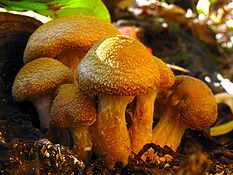
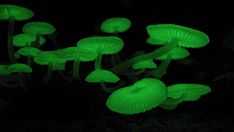
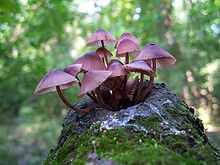
_Gray_187424.jpg)
